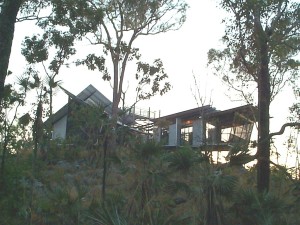 The Rozak House was designed and built by Troppo Architects in 2001 for Michael Rozak, a retired computer programmer, who lived in the house until his death in August 2013. The house has won a number of prestigious architectural awards for it’s unique design philosophy, which deliberately conforms to the tropical environment of Australia’s Northern Territory.
The Rozak House was designed and built by Troppo Architects in 2001 for Michael Rozak, a retired computer programmer, who lived in the house until his death in August 2013. The house has won a number of prestigious architectural awards for it’s unique design philosophy, which deliberately conforms to the tropical environment of Australia’s Northern Territory.
The elevated house is divided into three sections, the main living area with kitchen, dining room, and living room, and two bedroom wings, each of which has two bedrooms and a full bath. Dividing the house into three sections maximizes the breezes because each section is only one room deep. As a side-benefit, every room has a view. And, it solves some of the intra-house noise problems. The house feels larger than it actually is. Even though the house is only about 200 square meters, it’s 30 meters from end to end.
The house’s structure is entirely steel. The roof and walls are zincalum corrugated metal. It’s long lasting, termite safe, and non-flammable. The metallic zincalum coating reflects much of the sunlight, keeping the house cool.
Inside, the ceiling is zincalum coated corrugated metal. The metallic zincalum coating brightens up the inside, saving on artificial lighting. And more importantly, it is easy to clean and long lasting. The ceiling can be unscrewed to access the wiring. Otherwise, sheetrock ceilings get stained, and in Darwin, they sag after a few years because of all the humidity and inevitable leaks in the roof. (When a cyclone dumps 10 cm of rain in a couple of hours, all leaks are exposed.)
The interior walls are plywood, which is easy to clean and fairly difficult to damage. In contrast sheetrock is much more fragile and ages quickly in the humidity. Plus, the plywood sheets can be unscrewed to expose wiring and piping behind the walls, making for easy repairs and upgrades. Looking behind the walls once in awhile also provides peace-of-mind, knowing that termites haven’t built any galleries there.
Most of the floors are decking hardwood. While the decking gaps pose a problem sweeping (the dirt always seems to fall between the slats), they are a savior when a combined rainstorm and windstorm hit. Any rain blown into the house drips out between through the gaps. Furthermore, the gaps improve airflow and add to the house’s “effect.” Visitors not only have views all around them through the louvers and insect screen, but they can look through the floor at the ground several meters below.
The kitchen and bathroom floors are slate because they’re the most likely to get dirty. It’s easier to mop slate than pry out bits of food from between hardwood decking. Mike chose to use slate instead of ceramic tile because the house site is very rocky, and the stone floor merges the interior of the house with the exterior ground.
The house’s walls are mostly windows, either louvered windows or insect screening. Not only is insect screening cheaper than louvers, but it is barely visible. People feel much more exposed to nature, especially when a downpour is blown in through the screens.
